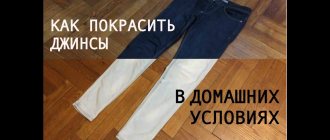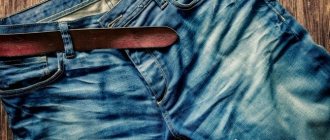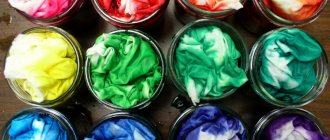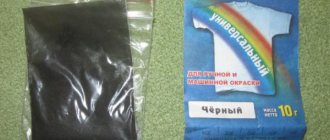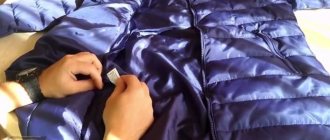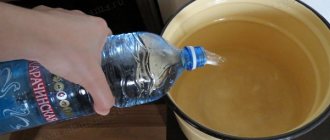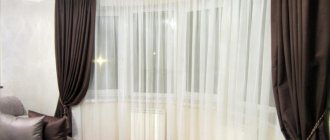Is it possible to dye fabric green?
Important! Paint
You can
coat your clothes
with green paint
evenly at home, without streaks or stains, only if you periodically turn the product over in the container. The same rule applies when you decide to change the shade of tulle, curtains, nylon mesh or any other textile.
Interesting materials:
How much RAM should a tablet have? How much RAM does Android 8 need? How much RAM does a browser need? How much RAM does a 64 bit system support? How much RAM does the iPad 2022 have? How much RAM does Honor 10 Lite have? How much RAM does iPad Air 2022 have? How much RAM does iPad Pro 2022 have? How much RAM does iPad Pro 2022 have? How much RAM does iPad have?
How to choose clothes paint
There are a total of six types/types of fabric dyes. But not all of them are suitable for home use. We will only talk about those that can be used at home.
You can get black color without a tint using acrylic fabric paint
To update the color
The most common and cheapest dyes for things and fabrics are aniline. But it is worth knowing that they give a “transparent” color. This means that you won’t be able to radically change the color of an item or fabric with their help. Even if you paint a thing black, the previous one will “look through” it.
You can refresh faded color using aniline dyes
If you want to dye your clothes because there is a stain on it, aniline pigment will not cover it either. The stain may become less noticeable, but it will still be there. Aniline dyes are good for updating color, but not for changing it.
When dyeing textiles with aniline dye, after all areas are dyed, add salt diluted in hot water. Bring the dye solution with salt and the placed item to a temperature of 80-90°C. This will fix the pigment. In this case, the solution becomes transparent, and the color of the textile becomes brighter.
When painting things blue or green, use thick rubber gloves.
Hands paint even better than fabrics. You can already rinse without gloves . Blue, brilliant green, and fucorcin can also be classified as aniline dyes. These are substances of the same group as aniline pigments. They just have “side” effects—disinfecting properties, thanks to which they have found their use in medicine. They can also be used to refresh the color of products of a similar color scheme. For example, bluing is suitable for bluing jeans and blue T-shirts. To refresh the green color - brilliant green. Well, pink or red-brown things will be updated by fukortsin. All these pharmaceutical preparations dissolve in water and are well absorbed into natural fabrics. But you will have to wash the “refreshed” items separately, otherwise everything else will be tinted.
For plain coloring and painting
To obtain a “thick” color, use acrylic fabric paints. They are sold in the form of powder, spray, paste. They are also good for painting fabrics, so you can find them in craft stores. They can have a variety of “effects” - glitter, pearl, glow in the dark.
Acrylic textile paints are the best choice for dyeing natural or mixed fabrics. Using DECOLA paint, you can even paint on fabric
Acrylic paints can be labeled Textil or Batik. To dye fabric, textile ones are more suitable. They even work with heavy materials such as velor or cotton/viscose knitwear. Acrylic batik paint is good for thin, lightweight fabrics.
This type of paint can be used both for uniform monochromatic coloring and for creating designs. There are even markers for painting clothes for these purposes. They can be washable or permanent. Washable ones disappear after 2-3 washes.
How to dye knitwear and wool
Knitwear and wool are dyed with special compounds that do not require high temperatures. They can be in the form of powders or pastes. For example, there are cube pigments for dyeing woolen products and embossed knitwear. They do not dissolve in water - to dye, you need to add soda to the water, then the pigment, and stir well. After dyeing, the item must be soaked/rinsed in water and vinegar. An acidic environment transforms them back into an insoluble state, that is, the pigment is “fixed” on the fabric.
This paint can be used to dye a wool sweater.
There are acid dyes for wool in the form of powders or pastes. They dissolve well in water, but they themselves contain acids, which create the required environment for pigment dissolution.
You need to be careful with yellow and orange shades of vat paints - they increase the impact of ultraviolet radiation, which accelerates the destruction of fibers.
How to paint synthetics
As mentioned above, polyester and nylon are difficult to dye at home. There are dry cleaners that can do this, but even they do not provide guarantees.
Make sure there are no creases or “stable” folds. Seams or places where there are several layers of fabric, “crease” more actively with a spatula or stick
At the moment, there are only a few dyes for home dyeing of synthetics (acrylic, polyester, polyamide, nylon). Jacquard Idye Poly and Rit Dye More Synthetic work best. These are American paints.
Jacquard Idye Poly is sold in sachets that you throw into the water. Can be dyed by hand or in a washing machine. The paint also works at low temperatures - about 40°C. So it is also suitable for dyeing delicate fabrics (underwear, swimwear including).
Not many dyes are suitable for hand-dying synthetic fabrics
Rit DyeMore - color in a bottle. Designed specifically for dyeing synthetic fabrics. Suitable for mixed fabrics in which more than 35% are synthetic fibers. One important point: fabrics must be dyed at a temperature close to boiling point. Not all things can withstand this.
Rit DyeMore Liquid Dye - dyes synthetic and blended fabrics, including anything containing 35% or more polyester, acrylic, acetate or nylon. Ideal for rejuvenating faded clothing, hiding defects that appear during the washing process and much more.
General rules for dyeing a jacket
Experienced housewives know that repainting any clothes, especially a jacket, with their own hands is quite difficult. Therefore, for those who decided to do such an experiment for the first time, it is better to practice on old clothes that you don’t mind throwing away. The dyeing process consists of several stages:
- Using household scales, determine the mass of the product. This is necessary in order not to make a mistake with the amount of dye. The manufacturer always indicates how much paint is required depending on the weight of the jacket. To obtain a more saturated color, you need to take a little more coloring powder.
- The washed and stain-free jacket is soaked in warm water for half an hour. This will allow the dye to be evenly distributed throughout the entire product.
- Water is poured into the prepared container and heated to a temperature of 60 °C.
- The dye is diluted in a separate saucepan, for which a packet of powder is poured with a glass of hot water and mixed thoroughly. Liquid paint should also be dissolved in a small amount of water and only then poured into a container. Advice! To obtain a bright, rich color, add 100 ml of acetic acid to the container with the coloring solution.
- Place the pan with the dye solution on the stove, lower the jacket into the liquid and heat the water to boiling point. The jacket should be cooked over low heat for at least 20 minutes. During dyeing, while the container is on the stove, you must carefully stir the clothing with wooden tongs or a regular stick, trying to prevent the item from floating to the surface of the solution.
- At the end of the process, to fix the paint, pour a brine solution into the container, combining 50 g of table salt and 2 liters of water, and boil for a few more minutes.
- After the time specified in the instructions has passed, the jacket is removed from the solution and rinsed twice - the first time in cool water, the second time with the addition of 30 ml of vinegar.
It is better not to twist freshly dyed clothes, but to blot them with an unnecessary rag and lay them out to dry.
Tips and tricks
The procedure for repainting a jacket must be approached responsibly. It is strictly unacceptable to do this in a hurry, especially if you use a brush or foam rubber. It is very important to achieve uniform distribution of the dye over the entire surface of the product.
Before starting work, the item must be washed, dried, removed from dust and greasy stains, and smoothed out all wrinkles. Be sure to wear gloves and a respirator so that the chemical components of the paint do not irritate the mucous membranes. After dyeing, the first wash is carried out by hand and dried in the open air, avoiding direct sunlight.
You can change the color of the jacket using chemical dyes. They are selected taking into account the material of outerwear. If you strictly follow all the recommendations in the instructions, the color update will be successful.
How do you like the article?
Is it possible to paint Bolognese products?
Bolognese jackets are warm and inexpensive. The material is wear-resistant. Its disadvantage is the rapid loss of color brightness. Before restoring it, it is worth checking whether it is possible to paint a bolone jacket yourself.
Attention! Bolognese fabric is a polymer synthetic material that does not withstand high temperatures.
To recolor a jacket made of Bolognese synthetic fabric, you should take special dyes for nylon, acrylic, and nylon. In this case, you will not need to boil the item; it is enough to immerse it in water at a temperature of no more than 50 °C. The product is kept for the amount of time indicated on the packaging and then dried.
Features of choosing a dye
When deciding to renew faded clothing, you first need to study the composition of the material from which it is made. You can easily dye a jacket made of cotton, denim, or linen. But with synthetic fabrics you will have to tinker. Some synthetics cannot be painted at all - the paint simply flows off the surface of the product like water.
Polyester is often used as a synthetic material for outerwear. Jackets made from this fabric do not get wet, get dirty little, and last a long time. If the fabric is 100% polyester, it will be very difficult to dye. It is better when the material contains additional fibers such as cotton, linen, viscose, and the percentage of their content is at least 40.
Often, manufacturers of synthetic materials used for sewing outerwear treat the surface of the fabric with a special water-repellent composition. A thin protective film prevents paint from penetrating into the fibers of the material, which significantly complicates the dyeing process. The label always mentions the presence of such impregnation, so before starting painting it is very important to study all the information about your product.
The final coloring result is significantly influenced by the original color of the product. On the packaging of their product, the manufacturer always indicates the color that should be obtained after processing. We must remember that this only applies to dyeing white things. Otherwise, the result may be unpredictable. To paint colored items, it is better to choose a paint that is a shade darker.
Preliminary procedures
Before you start dyeing your coat, you need to assess the risks and make a firm decision whether it is worth doing. If there is no way out, then you need to act according to certain instructions. First of all, you need to determine the composition of the fabric, because it determines the quality of the work carried out in the future:
- Natural fibers - they can be dyed any color.
- Synthetic fabrics - this procedure is not suitable for them, since it is impossible to achieve the desired result.
- Combined - the shade of the dyed coat will be slightly lighter than expected.
Important! Unscrupulous manufacturers may lie and indicate information on the tag that is not true. In order not to spoil the item, you need to do the procedure in a small and inconspicuous area.
As for the choice of color, experts do not recommend bold experiments, leaving the coat in approximately the same color as it was originally. It is best to choose a color several shades darker, so that the experiment will end successfully and the item will delight you with its attractive appearance.

